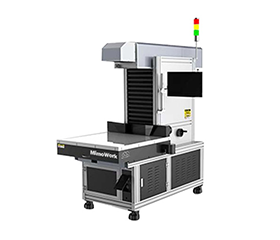Laser Engraving Heat Transfer Vinyl
What is Heat Transfer Vinyl (HTV)?

Heat transfer vinyl (HTV) is a material used for creating designs, patterns, or graphics on fabrics, textiles, and other surfaces through a heat transfer process. It typically comes in roll or sheet form, and it has a heat-activated adhesive on one side.
HTV is commonly used for creating custom T-shirts, apparel, bags, home decor, and a wide range of personalized items. It's popular for its ease of use and versatility, allowing for intricate and colorful designs on various textiles.
Laser cutting heat transfer vinyl (HTV) is a highly precise and efficient method for creating intricate and detailed designs on vinyl material used for custom apparel and fabric decoration.
Few Important Points: Laser Engraving Heat Transfer Vinyl
1. HTV Types:
There are different types of HTV available, including standard, glitter, metallic, and more. Each type may have unique properties, such as texture, finish, or thickness, which can affect the cutting and application process.
2. Layering:
HTV allows for layering multiple colors or designs to create intricate and multicolored designs on clothing or fabric. The layering process may require precise alignment and pressing steps.

3. Fabric Compatibility:
HTV is suitable for various fabrics, including cotton, polyester, and blends. However, results may vary based on the fabric type, so it's a good practice to test a small piece before applying it to a larger project.
4. Washability:
HTV designs can withstand machine washing, but it's important to follow the manufacturer's care instructions. Typically, designs on fabric can be washed and dried inside out to prolong their lifespan.
Common Applications for Heat Transfer Vinyl (HTV)
1. Custom Apparel:
Personalized t-shirts, hoodies, and sweatshirts.
Sports jerseys with player names and numbers.
Customized uniforms for schools, teams, or organizations.
3. Accessories:
Customized bags, totes, and backpacks.
Personalized hats and caps.
Design accents on shoes and sneakers.
2. Home Decor:
Decorative pillow covers with unique designs or quotes.
Customized curtains and draperies.
Personalized aprons, placemats, and tablecloths.
4. DIY Crafts:
Custom vinyl decals and stickers.
Personalized signs and banners.
Decorative designs on scrapbooking projects.
Video Demonstration | Can A Laser Engraver Cut Vinyl?
The Fastest Galvo Laser Engraver for Laser Engraving Heat Transfer Vinyl will get you a big leap in productivity! Can A Laser Engraver Cut Vinyl? Absolutely! Cutting vinyl with laser engraver is the trend in making apparel accessories, and sportswear logos. High speed, perfect cutting precision, and versatile materials compatibility, helping you with laser cutting heat transfer film, custom laser cut decals, laser cut sticker material, laser cutting reflective film, or others.
To get a great kiss-cutting vinyl effect, the CO2 galvo laser engraving machine is the best match! Unbelievably the whole laser cutting htv took only 45 seconds with the galvo laser marking machine. We updated the machine and leaped cutting and engraving performance. It’s the real boss in vinyl sticker laser cutting machine.
Have Any Confusion or Questions About Laser Engraving Heat Transfer Vinyl?
Comparison of Different Cutting Methods for Heat Transfer Vinyl (HTV)
Plotter/Cutter Machines:
Pros:
Moderate initial investment: Suitable for small to medium businesses.
Automated: Provides consistent and precise cuts.
Versatility: Can handle various materials and different design sizes.
Suitable for moderate production volumes and frequent use.
Laser Cutting:
Pros:
High precision: For intricate designs with exceptionally detailed cuts.
Versatility: Can cut various materials, not just HTV.
Speed: Faster than manual cutting or some plotter machines.
Automation: Ideal for large-scale production or high-demand projects.
Cons:
Limited for large-scale production.
Initial setup and calibration are required.
Still may have limitations with very intricate or detailed designs.
Cons:
Higher initial investment: Laser cutting machines can be costly.
Safety considerations: Laser systems require safety measures and ventilation.
Learning curve: Operators may need training for efficient and safe use.
For small businesses and moderate production volumes, a plotter/cutter machine is a cost-effective option.
For intricate and large-scale production, especially if you're handling different materials, laser cutting is the most efficient and precise choice.
In summary, the choice of cutting method for HTV depends on your specific needs, budget, and the scale of your production. Each method has its advantages and limitations, so consider what suits your situation best.
Laser cutting stands out for its precision, speed, and suitability for high-demand projects but may require a more significant initial investment.
Fun Facts about Heat Transfer Vinyl (HTV)
1. Versatile Material:
HTV comes in a wide range of colors, patterns, and finishes, allowing for endless creative possibilities. You can find glitter, metallic, holographic, and even glow-in-the-dark HTV.
2. Easy to Use:
Unlike traditional screen printing or direct-to-garment methods, HTV is user-friendly and requires minimal equipment. All you need is a heat press, weeding tools, and your design to get started.
3. Peel-and-Stick Application:
HTV has a clear carrier sheet that holds the design in place. After heat pressing, you can peel away the carrier sheet, leaving behind the transferred design on the material.
4. Durable and Long-Lasting:
When applied correctly, HTV designs can withstand numerous washes without fading, cracking, or peeling. This durability makes it a popular choice for custom apparel.







